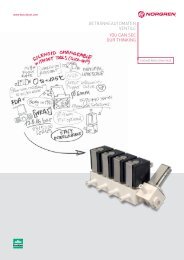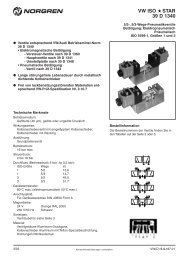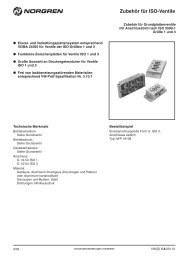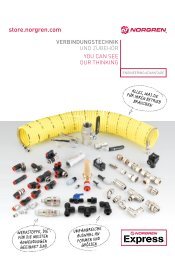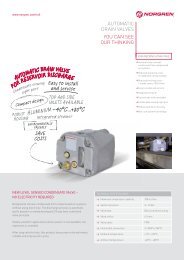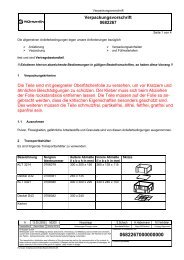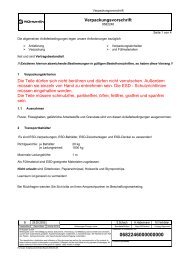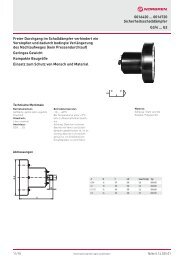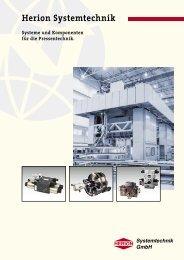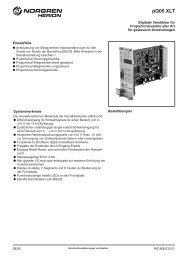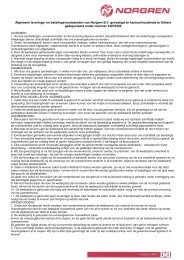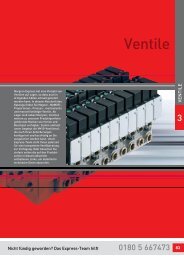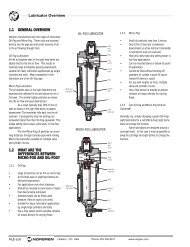Energy saving in compressed air systems - Norgren Pneumatics ...
Energy saving in compressed air systems - Norgren Pneumatics ...
Energy saving in compressed air systems - Norgren Pneumatics ...
Create successful ePaper yourself
Turn your PDF publications into a flip-book with our unique Google optimized e-Paper software.
to sophisticated and extensive special purpose mach<strong>in</strong>es and <strong>systems</strong>.<br />
How to improve energy efficiency<br />
The ma<strong>in</strong> causes of wasted energy are leaks, pressure drops, over pressurization, misuse<br />
of jets and poor compressor management.<br />
An example factory has an <strong>in</strong>stalled compressor capacity of 1,500 cfm, and average<br />
demand of 1000 cfm. It operates 24 hours per day, 7 days per week, for 50 weeks a year.<br />
Electricity costs 0.068 $/kWh (national US average 99). The compressor duty cycle is<br />
75%. To evaluate the power needed: 4.5 cfm compressor capacity require 1 compressor<br />
horsepower. The total runn<strong>in</strong>g cost is then $107,000 per year.<br />
If the <strong>compressed</strong> <strong>air</strong> system has many of the commonly found problems, it is likely that<br />
around 30% of the <strong>air</strong> produced is wasted. Cur<strong>in</strong>g the problems will yield a fast payback<br />
and substantial <strong>sav<strong>in</strong>g</strong>s of $ 32,100 <strong>in</strong> the first year.<br />
Leakage<br />
Because <strong>compressed</strong> <strong>air</strong> leaks do not make a mess like oil leaks, it is easy to ignore them.<br />
The cont<strong>in</strong>uous hiss of leaks is usually dismissed as part of the general background and is<br />
often drowned by the higher noise levels from mach<strong>in</strong>ery. Generation capacity is<br />
frequently <strong>in</strong>creased needlessly, when simply fix<strong>in</strong>g the leaks would have restored system<br />
efficiency.<br />
At a considerable high price it is well worth establish<strong>in</strong>g a planned ma<strong>in</strong>tenance rout<strong>in</strong>e<br />
that is <strong>in</strong>tolerant of leaks. Leakage is the major source of energy loss <strong>in</strong> <strong>compressed</strong> <strong>air</strong><br />
<strong>systems</strong>. A typical plant may lose up to 30% of its <strong>compressed</strong> <strong>air</strong> through poorly<br />
ma<strong>in</strong>ta<strong>in</strong>ed pipe jo<strong>in</strong>ts, fitt<strong>in</strong>gs, coupl<strong>in</strong>gs and equipment.<br />
Where to f<strong>in</strong>d leaks<br />
Ag<strong>in</strong>g pipework particularly at corroded jo<strong>in</strong>ts and take off po<strong>in</strong>ts.<br />
Flange connectors where gaskets and pipe dope need replac<strong>in</strong>g.<br />
Fitt<strong>in</strong>gs that have worked loose or have had excessive stra<strong>in</strong> placed on them.<br />
Manifolds with closely spaced connections. These can be easy to ignore when a leak<strong>in</strong>g<br />
fitt<strong>in</strong>g is difficult to access.<br />
Flexible hoses with cuts and splits caused by stra<strong>in</strong> and abrasion.<br />
Coupl<strong>in</strong>gs with damaged seals. Grit may have been picked up dur<strong>in</strong>g the break and<br />
make process.<br />
Dra<strong>in</strong> valves found on <strong>air</strong> receivers, drip leg dra<strong>in</strong>s, filters and other equipment can<br />
become stuck open due to pipe scale and sludge or even <strong>in</strong>tentionally left partially open<br />
to avoid the ma<strong>in</strong>tenance rout<strong>in</strong>e.<br />
Pneumatic components <strong>in</strong>clud<strong>in</strong>g tools, valves and actuators are all subject to worn and<br />
damaged seals result<strong>in</strong>g <strong>in</strong> leaks.<br />
Page 2 of 8



